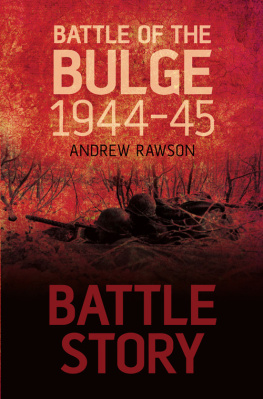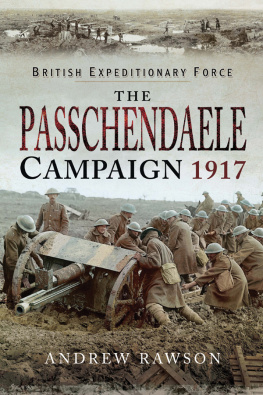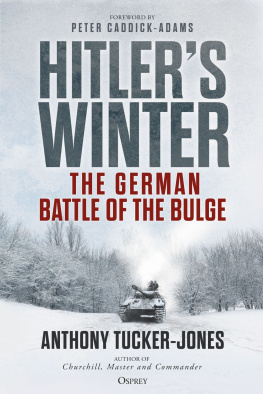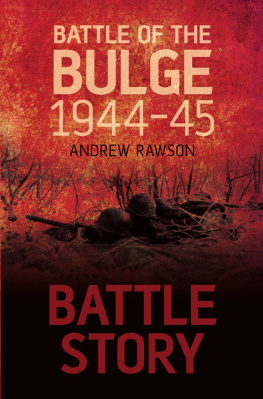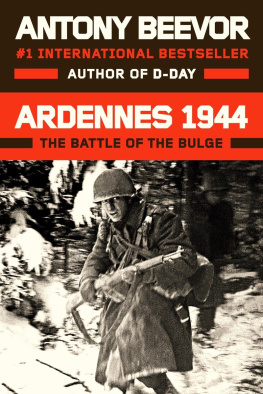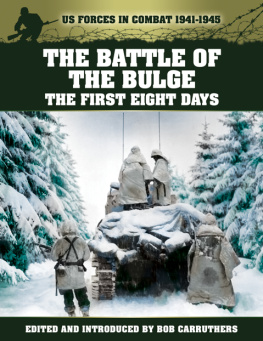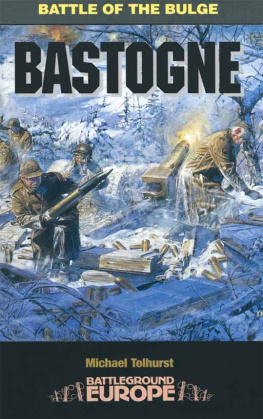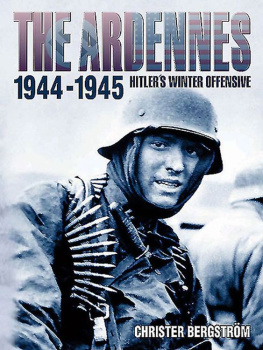

A dark sense of humour prevailed during the siege of Bastogne. (NARA 111-SC-226804)
CONTENTS
Conceiving the Plan
Reinforcing the Wehrmacht
Jodl Draws up Hitlers Ideas
The Generals Reaction
The Ardennes Battlefield
The German Commanders
The Allied Commanders
The US Army Commanders
Army Group Bs Final Planning
Operation Wacht am Rhein: Army Group B Order of Battle and Objectives
The Allied Situation
The Soldiers
The Kit
The Tactics
The Days Before Battle
Deceiving the Allies
Assembling for Battle
1617 December Operation Wacht Am Rhein Begins
1819 December Army Group Bs Breakthrough Begins
2021 December The Battles for St. Vith and Bastogne
Protecting the Meuse Bridges
2223 December Army Group Bs High Water Mark
2425 December The Counteroffensive Intensifies
26 December Onwards Driving Army Group B Back
Operation Nordwind
Eliminating the Bulge
The Cost
Analysing the Ardennes Battle
The Place of the Ardennes Offensive in the Second World War

The bullet-scarred sign went back to Fort Campbell. (NARA 111-SC-200445)
On the morning of 6 June 1944 Allied troops made airborne and seaborne landings on the coast of Normandy and by nightfall they had established a slender beachhead. The long awaited battle for the Second Front had started and over the next six weeks the British and Commonwealth soldiers serving under Field Marshal Bernard Montgomery and the American soldiers under General Omar Bradley fought to expand their foothold in Nazi-occupied Europe.
While the British drew in German reserves around the town of Caen, the Americans fought inch by inch through the Normandy bocage as reinforcements poured into the beachhead. Finally, the breakthrough came on 25 July when First US Army launched Operation Cobra. As Montgomerys 21st Army Group advanced south from Caen, Bradleys 12th Army Group pushed south to Avranches before turning east in a huge arc to try and encircle Army Group B. General Eisenhowers plan nearly worked and large numbers of Field Marshal Walter Models men were trapped in what became known as the battle for the Falaise Pocket.
The Allied Armies advanced quickly across France while the remnants of OB West fell back in disorder towards Germany and the safety of the West Wall (also known as the Siegfried Line), a long line of fortifications along the border, the Allied Armies followed as fast as they could. While Montgomerys 21st Army Group entered Belgium and entered Brussels on the north flank, Bradley advanced east, liberating Paris before heading towards the German border. Following a second successful Allied landing in southern France General Jacob Devers 6th Army Group pushed quickly up the Rhne Valley and linked up with Bradleys advance. However, while progress was exceeding all expectations the advance started to falter by mid September because of mounting difficulties in keeping the front line troops supplied. The Germans either held onto ports or destroyed them, leaving the Allies reliant on bringing supplies over the beaches. The destruction of the French rail network meant that everything had to be moved by lorry. With summer turning to autumn, Eisenhower was concerned that his Armies would find themselves stranded in front of the Siegfried Line at the end of a tenuous supply line.
An attempt to outflank the fortified line by pushing through Holland was suggested by Montgomery and approved; on 17 September Operation Market Garden was launched. The plan was to cross the Maas, Waal, and Rhine rivers in southern Holland using British and American airborne troops to pave the way for the ground troops but after a fleeting glimpse of success, German reserves moved in to stop 21st Army Group just short of its final objective. The failure to cross the Rhine left Eisenhower needing to reconsider his options.
An attempt on Hitlers life in the Wolfs Lair on 20 July 1944 and the subsequent purge of the Armed Forces High Command, in which many senior officers were executed, had made the Fhrer paranoid. The purge had gone right to the top and Generalfeldmarschall Gnther von Kluge committed suicide when implicated in the plot.
With the Soviet Armies winning the battle for the Eastern front, Hitler wanted to focus on defeating the Allies in the West and on 31 July the Fhrer made the declaration that the war had to be won in the West and that the Allied armies had to be stopped from breaking out of Normandy. The Wehrmacht could not halt them and over the next six weeks they advanced across France and Belgium. As the Allied advance ground to a halt on Germanys border, Hitler conceived the offensive in the Ardennes; a counterattack designed to win the war.
The day before Operation Market Garden was launched, OKWs staff were holding a briefing at Hitlers headquarters in East Prussia, a place known as the Wolfs Lair. General Alfred Jodl, OKWs Chief of Operations Staff, was explaining the situation on the Western Front and it was looking bad for Wehrmacht. Allied divisions outnumbered the Germans by two to one and the Americans had just crossed the German border at Aachen. As he went on to describe how most divisions were short of manpower, armour, heavy weapons and ammunition, Hitler interrupted and announced; I have just made a momentous decision. I shall go over to the counter-attack, here, out of the Ardennes, with the objective Antwerp.
Hitler also had a new Commander in Chief, West, to plan the offensive following Kluges suicide. On 1 September Field Marshal Gerd von Rundstedt took command having been sacked two months earlier for urging Hitler to make peace following the D-Day landings on the Normandy coast. He was ordered to stall the Allied advance across France and Belgium to give time for the West Wall to be strengthened. Meanwhile, secret planning to gather enough men, armour, artillery and ammunition to smash through the Allied line began immediately. It was going to take a tremendous effort to prepare for the offensive but the stakes were high; the survival of the Nazi regime depended on the Wehrmachts success.

Jodl, Hitler and Rundstedt; while Hitler conceived Operation Wacht am Rhein, Jodl and Rundstedt argued over the pros and cons of the Big Solution and the Small Solution.
European Campaign: 6 June 1944 to 8 May 1945
1944 |
6 June | Operation Overlord: D-Day, Allied airborne and seaborne landings on the north coast of France begins. The bloody battle through the Normandy bocage follows. |
25 July | Operation Cobra: The Allies breakout into open country begins. |
1221 August | The battle of the Falaise Pocket results in the destruction of a large part of Army Group B; the race across France begins. |
15 August | Operation Dragoon: The Allies land on the south coast of France and move quickly north up the Rhne valley. |
Next page
